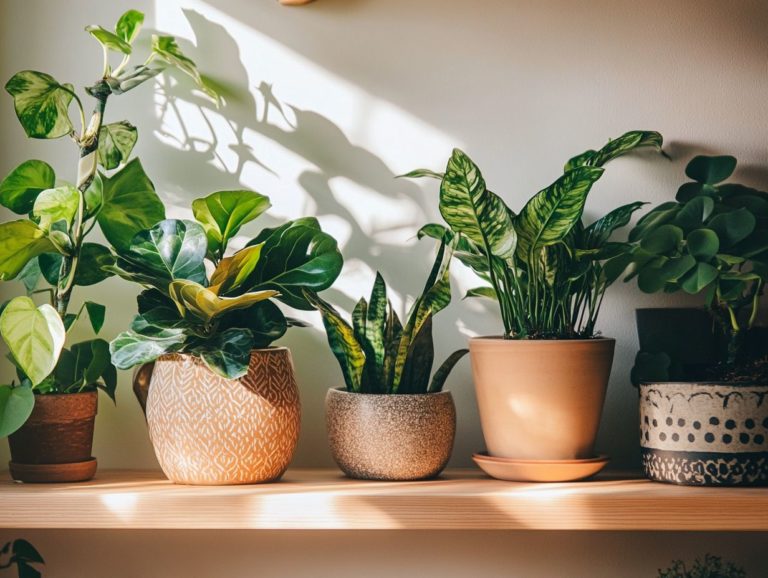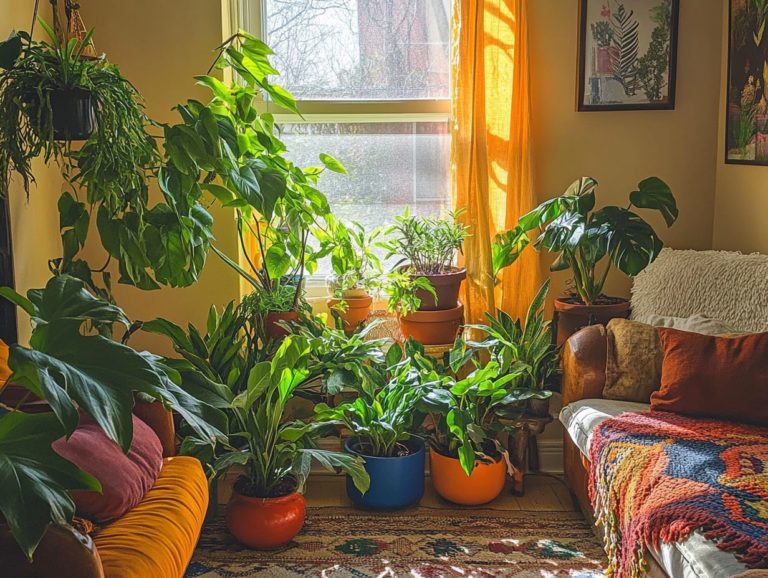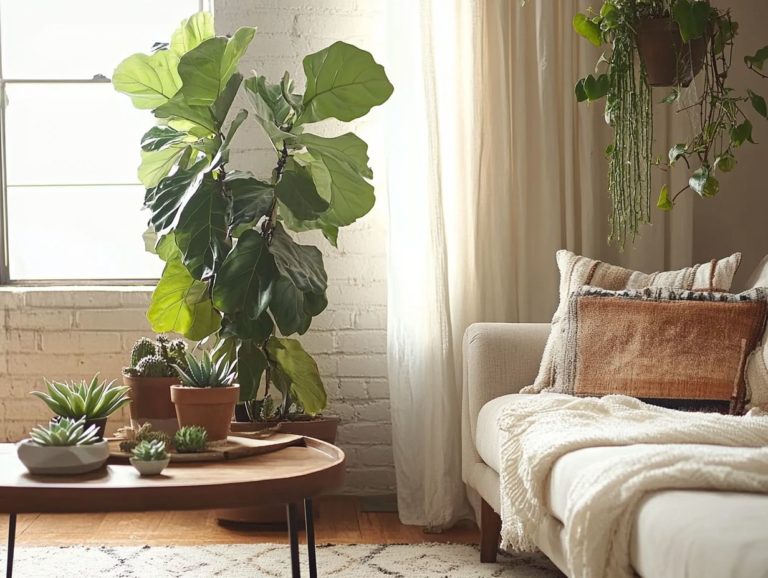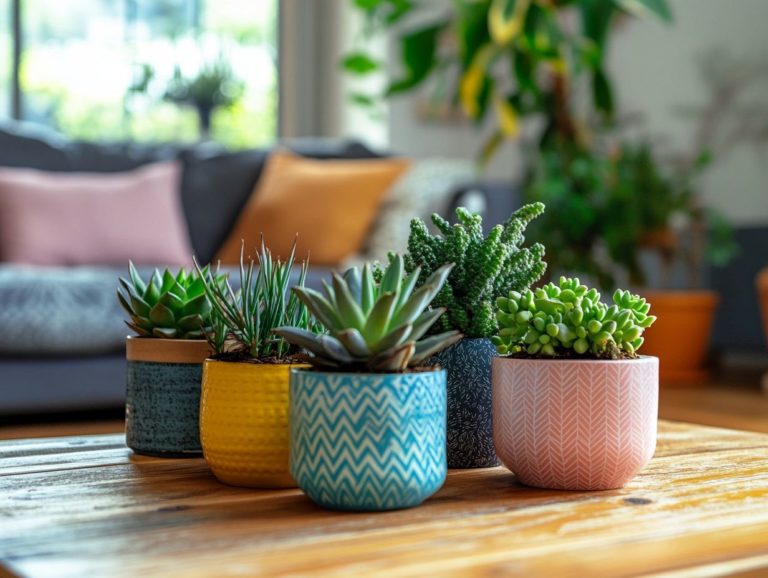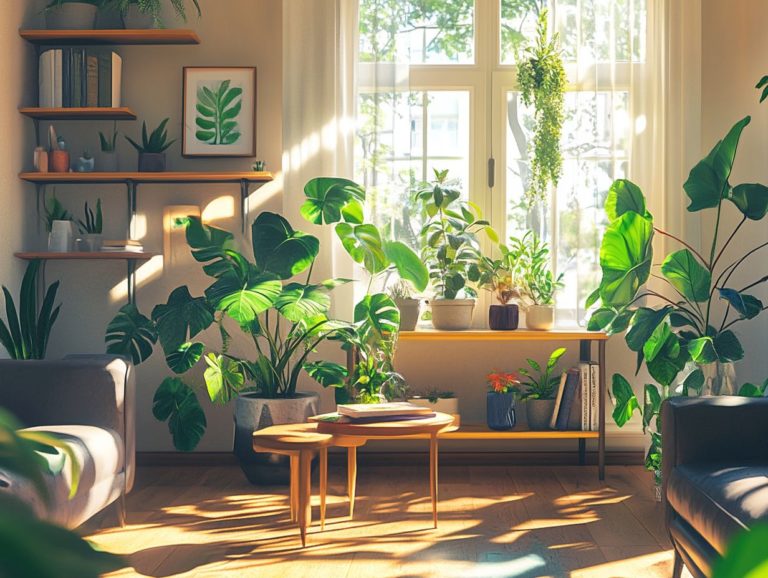Incorporating Indoor Plants into Kids’ Rooms
Indoor plants have the remarkable ability to transform your child’s room into a vibrant sanctuary that fosters well-being and sparks creativity, making it a true nature nook.
With benefits such as improved air quality and enhanced mental health, incorporating greenery goes far beyond mere decoration it s a genuine wellness initiative. This guide delves into how you can select the perfect plants, ensuring they are both safe and low-maintenance for your little ones.
You ll find inventive display ideas, essential care tips, and engaging ways to involve your children in nurturing their leafy companions. Discover how indoor plants can transform your child’s space into a lively haven!
Don t wait start transforming your child’s room today!
Contents
- Key Takeaways:
- Benefits of Indoor Plants in Kids’ Rooms
- Choosing the Right Plants for Kids’ Rooms
- How to Add Plants to Kids’ Rooms
- Caring for Indoor Plants in Kids’ Rooms
- Teaching Kids About Plant Care
- Frequently Asked Questions
- 1. Can indoor plants really thrive in a kids’ room?
- 2. How can incorporating indoor plants benefit my child’s room?
- 3. Do indoor plants require a lot of maintenance?
- 4. Are there any safety concerns with having plants in kids’ rooms?
- 5. How can I incorporate plants into my child’s room without taking up too much space?
- 6. Are there any specific plants like Aloe and lavender that are known to improve sleep for children?
Key Takeaways:
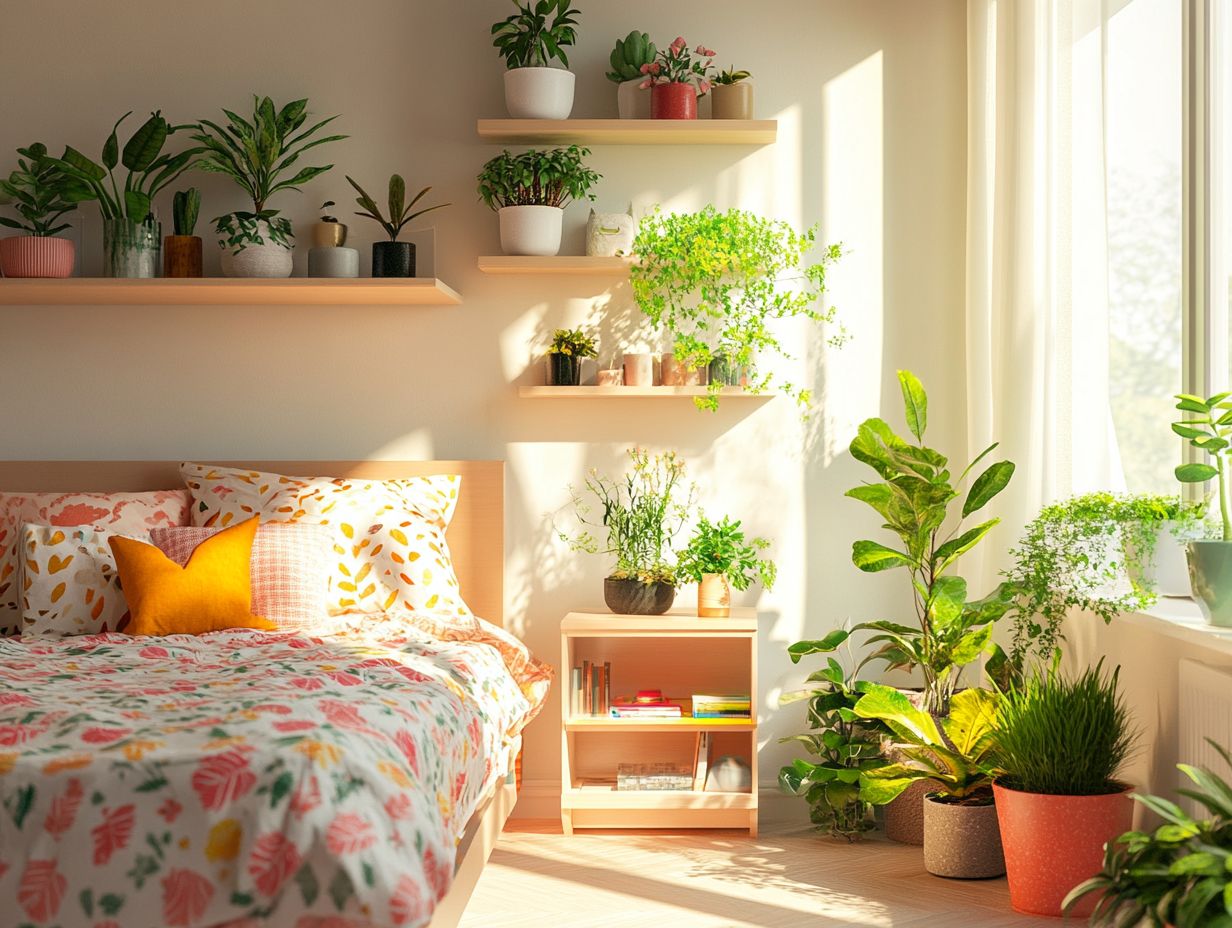
- Indoor plants in kids’ rooms can improve air quality and promote mental health.
- Choose low-maintenance and safe plants, such as spider plants and succulents, for kids’ rooms.
- Get creative with plant displays, like hanging planters and wall-mounted shelves, to incorporate plants into kids’ rooms.
Benefits of Indoor Plants in Kids’ Rooms
Integrating indoor plants into your kids’ rooms brings a wealth of benefits that elevate both the aesthetic charm and overall well-being of the space. Houseplants add vibrant green. They enhance the space’s beauty and play a crucial role in improving air quality, fostering a healthier atmosphere.
Their calming presence promotes mental health and alleviates stress, allowing your children to feel more relaxed and focused as they engage in creative activities or explore educational pursuits.
Improving Air Quality and Mental Health
The presence of houseplants in your child’s room can significantly enhance air quality and elevate mental health, offering a natural source of stress relief and tranquility. They function as living air purifiers (These are plants that help clean the air by removing harmful substances.), absorbing pollutants and releasing oxygen, thereby creating a healthier environment.
Take the spider plant, for example; it s celebrated for its remarkable ability to filter out harmful toxins such as formaldehyde and carbon monoxide. Research from environmental psychology experts indicates that plants like lavender and peace lilies can effectively lower anxiety levels, fostering a sense of calm and focus.
By engaging your children in the care of these plants, you cultivate a sense of responsibility and a deeper connection to nature, ultimately contributing to their emotional well-being.
Choosing the Right Plants for Kids’ Rooms
When selecting the perfect houseplants for kids’ rooms, consider maintenance requirements and safety. By choosing low-maintenance plants, you can keep children engaged in caring for their green companions without overwhelming them with responsibilities.
Plants such as the Spider Plant and Aloe are excellent choices; they are not only safe for little hands but also remarkably easy to care for, making them ideal additions to a child’s environment. For more inspiration, check out these indoor plant styling tips for every room.
Best Plants for Low Maintenance and Safety
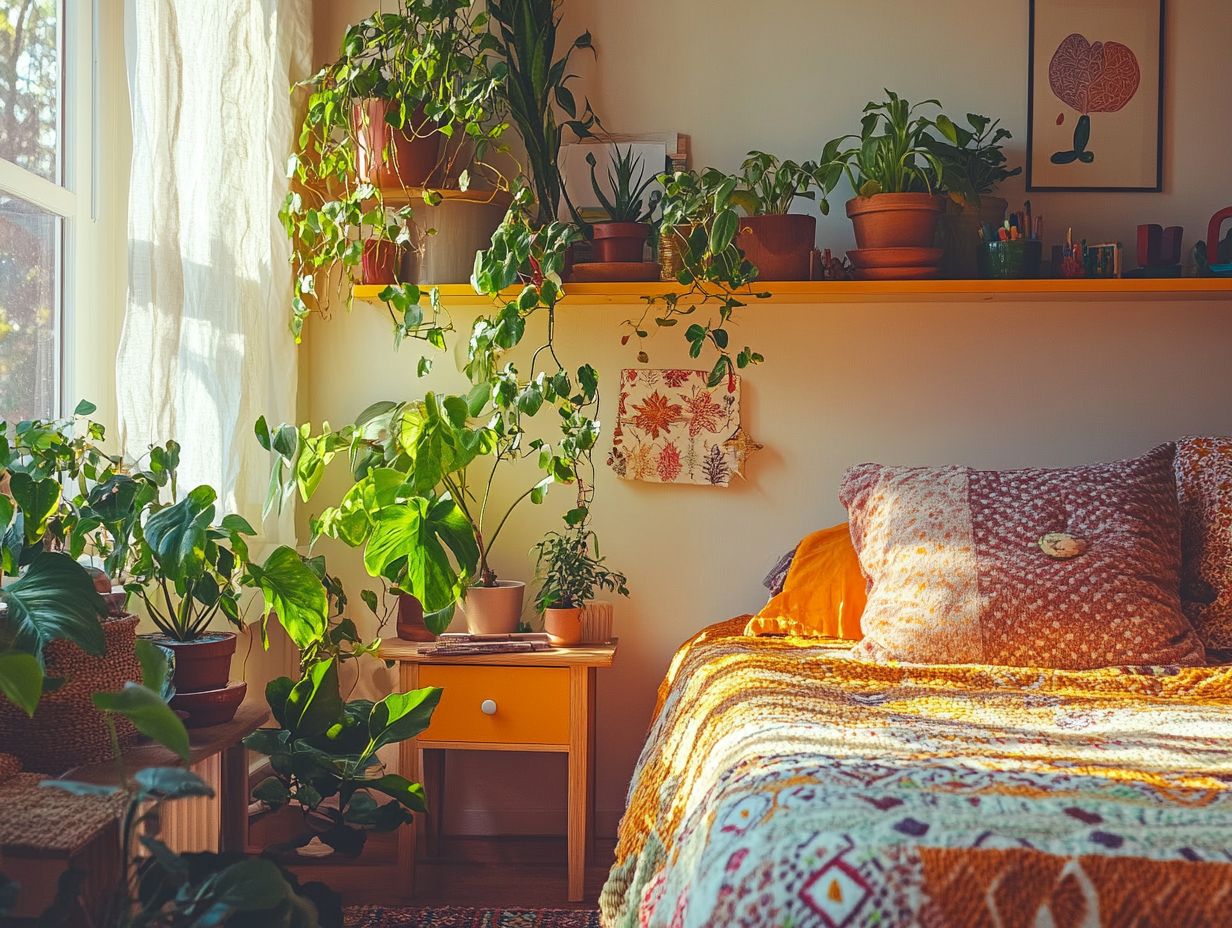
When selecting houseplants for a child’s room, consider options like the Spider Plant, Aloe, Kalanchoe, Snake Plant, and Rubber Tree. These choices stand out due to their low maintenance and safety features.
These plants thrive with minimal care, enhancing the indoor environment and making them perfect companions for young ones. For instance, the Spider Plant is incredibly forgiving and is celebrated for its air-purifying abilities, igniting curious conversations about nature and ecology. Meanwhile, Aloe, with its succulent leaves, encourages children to explore themes of medicinal properties and the significance of hydration. Discover more about the best indoor plants for kids’ rooms to create a nurturing space.
Kalanchoe adds a splash of color with its vibrant blooms, providing opportunities to teach children about color recognition and plant life cycles. By incorporating these easygoing plants into their spaces, parents can nurture an interest in indoor gardening while creating a safe and encouraging environment for their kids.
How to Add Plants to Kids’ Rooms
Adding houseplants to your child’s room can transform the space into a vibrant nature nook. It enhances the room’s charm and brings functional benefits through creative decorating ideas.
You can position plants as decorative accents on shelves or create dedicated green corners. The possibilities in modern interior design are endless!
Creative and Safe Display Ideas
Display ideas for houseplants can include wall-mounted pots and whimsical terrariums. These options not only look great but also keep safety in mind.
One fun project is creating a terrarium. It beautifies the room and teaches kids about plant care!
To keep plants out of reach, place terrariums on high shelves or use transparent containers. This keeps safety a priority while allowing kids to learn about their green surroundings.
Caring for Indoor Plants in Kids’ Rooms
Caring for indoor plants is essential for a healthy environment. It helps the plants thrive and offers stress relief while connecting kids to nature.
By sharing simple maintenance tips, you can turn this into an enjoyable and educational experience for your children.
Maintenance Tips and Tricks

Effective maintenance includes regular watering, proper lighting, and monitoring plant health. This creates a fun indoor gardening experience.
Set a routine, like watering every Sunday, to engage your children. They ll develop a sense of responsibility as they learn about different plants’ unique needs.
Common problems like yellowing leaves may mean over-watering, while brown edges could indicate low humidity. Teach kids to recognize these signs to build problem-solving skills.
Position plants near windows for sunlight but avoid drafts. This keeps indoor plants healthy and enriches their learning experience.
Teaching Kids About Plant Care
Teaching kids about plant care builds responsibility. It also includes lessons that deepen their understanding of nature.
When kids help care for plants, they develop a lifelong appreciation for them.
Involving Kids in Plant Care and Responsibility
Involving kids in plant care nurtures responsibility and opens the door to educational opportunities. Assign them tasks like watering or crafting vibrant plant markers.
Engaging in projects like designing a small herb garden turns gardening into an adventure! This hands-on experience helps kids develop essential life skills.
As they witness their plants grow, they gain a deeper appreciation for nature. Every moment in the garden becomes a rewarding journey.
Frequently Asked Questions
1. Can indoor plants really thrive in a kids’ room?
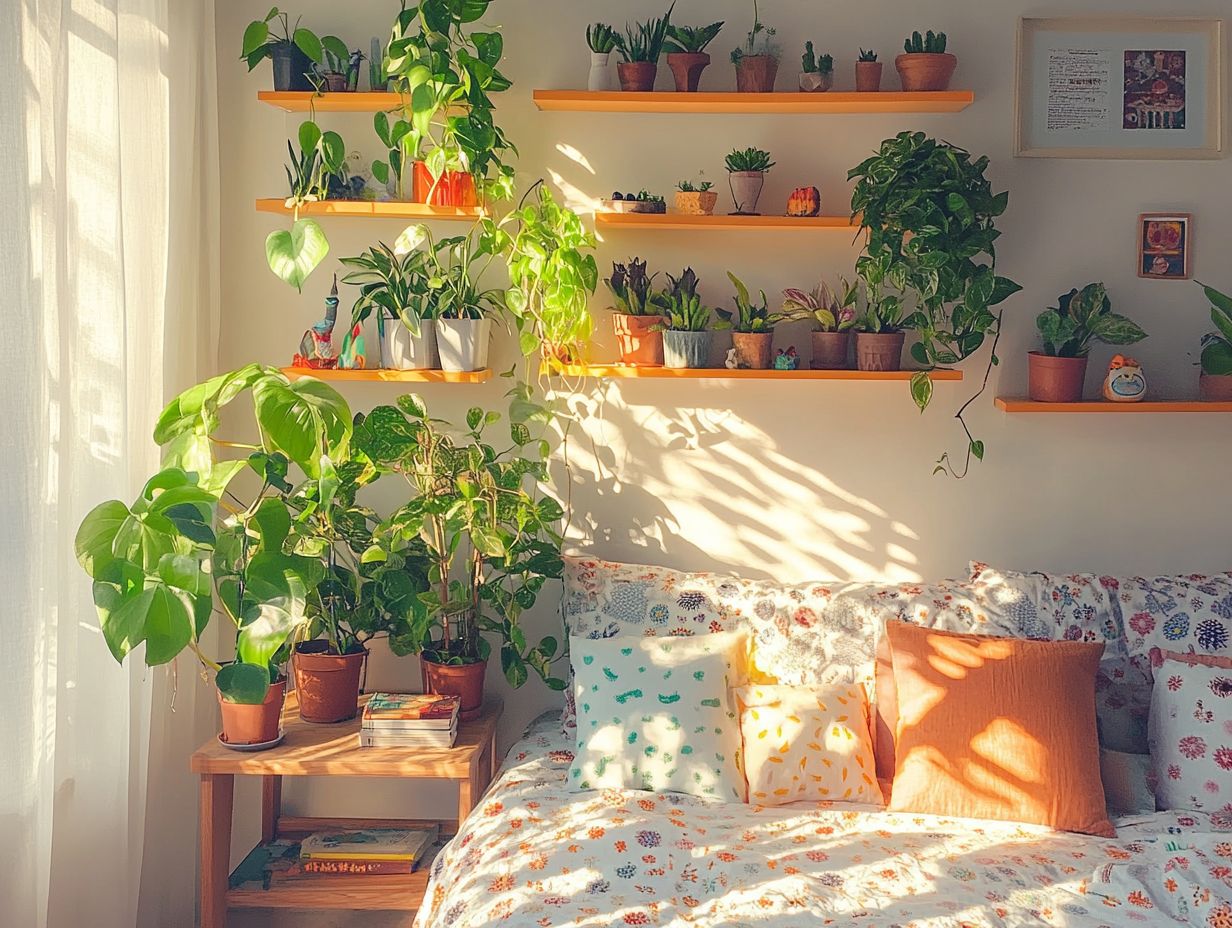
Yes! Now is the perfect time to bring some plants into your child’s room. There are many indoor plants that are safe and suitable for kids’ spaces. Popular options include spider plants, pothos, and plants that store water in their leaves, known as succulents.
2. How can incorporating indoor plants benefit my child’s room?
Indoor plants add a touch of nature and beauty to a room. They also offer health benefits by improving air quality, reducing stress levels, and boosting productivity and creativity.
3. Do indoor plants require a lot of maintenance?
It depends on the type of plant you choose. Some plants, like succulents, need minimal care and can thrive in low-light conditions. However, other plants may need more attention and regular watering.
4. Are there any safety concerns with having plants in kids’ rooms?
While safe plants that are good for the environment can be a wonderful addition to a kids’ room, it’s important to choose non-toxic varieties. Keep them out of reach of young children and teach kids not to ingest any parts of the plants.
5. How can I incorporate plants into my child’s room without taking up too much space?
There are many creative ways to add plants, even in limited spaces. Consider using hanging planters or wall-mounted shelves. Small plants, like the spider plant, can thrive on a windowsill. You can also opt for smaller plants that fit nicely on a desk or dresser.
6. Are there any specific plants like Aloe and lavender that are known to improve sleep for children?
Yes! Want to help your child sleep better? Consider these plants: Kalanchoe, Aloe, and Lavender all have calming properties. Jasmine, Rosemary, and Spathiphyllum also promote relaxation and better sleep in kids’ rooms.

